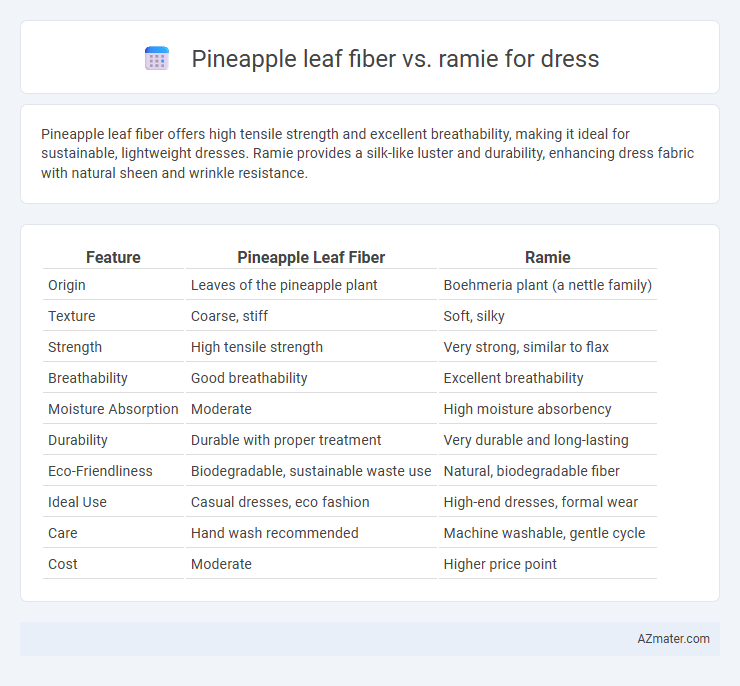Pineapple leaf fiber offers high tensile strength and excellent breathability, making it ideal for sustainable, lightweight dresses. Ramie provides a silk-like luster and durability, enhancing dress fabric with natural sheen and wrinkle resistance.
Table of Comparison
| Feature | Pineapple Leaf Fiber | Ramie |
|---|---|---|
| Origin | Leaves of the pineapple plant | Boehmeria plant (a nettle family) |
| Texture | Coarse, stiff | Soft, silky |
| Strength | High tensile strength | Very strong, similar to flax |
| Breathability | Good breathability | Excellent breathability |
| Moisture Absorption | Moderate | High moisture absorbency |
| Durability | Durable with proper treatment | Very durable and long-lasting |
| Eco-Friendliness | Biodegradable, sustainable waste use | Natural, biodegradable fiber |
| Ideal Use | Casual dresses, eco fashion | High-end dresses, formal wear |
| Care | Hand wash recommended | Machine washable, gentle cycle |
| Cost | Moderate | Higher price point |
Introduction: The Rise of Sustainable Fibers in Fashion
Pineapple leaf fiber and ramie are emerging as sustainable alternatives in the fashion industry, offering eco-friendly options for dressmaking. Pineapple fiber, derived from agricultural waste, provides a lightweight, breathable texture, while ramie, a bast fiber from the ramie plant, is valued for its strength and silky sheen. Both fibers contribute to reducing environmental impact by utilizing renewable resources and biodegradable materials in garment production.
Overview of Pineapple Leaf Fiber
Pineapple leaf fiber, derived from the leaves of the pineapple plant, is renowned for its strength, durability, and eco-friendly qualities, making it ideal for sustainable dress fabrics. It offers a natural sheen and breathability similar to ramie, but with superior tensile strength and resistance to wear, ensuring long-lasting garments. Pineapple leaf fiber's biodegradability and low environmental impact position it as a highly sustainable alternative for dress production compared to traditional fibers.
Overview of Ramie Fiber
Ramie fiber, derived from the stalks of the Chinese nettle plant, is renowned for its silky luster, strength, and durability, making it highly suitable for dress fabrics. Compared to pineapple leaf fiber, ramie is more resistant to wrinkling and has excellent moisture absorption, which enhances comfort in garment wear. Its natural sheen and ability to hold shape well contribute to elegant and breathable dresses favored in warm climates.
Environmental Impact: Pineapple Leaf Fiber vs Ramie
Pineapple leaf fiber production utilizes agricultural waste, significantly reducing environmental pollution and deforestation compared to ramie, which requires dedicated cultivation and higher water consumption. The biodegradability of pineapple leaf fiber further minimizes its ecological footprint, offering a sustainable alternative to ramie that often involves chemical processing and energy-intensive extraction. Choosing pineapple leaf fiber for dress materials supports eco-friendly fashion by promoting waste valorization and lowering greenhouse gas emissions.
Fiber Properties and Texture Comparison
Pineapple leaf fiber offers high tensile strength and natural stiffness, making it durable and resistant to wear, while ramie fiber is valued for its fine, silky texture and excellent moisture absorption, providing a smooth and breathable fabric ideal for dresses. Pineapple fiber's coarse texture contrasts with ramie's lustrous, soft feel, influencing the drape and comfort of garments. Both fibers are biodegradable and eco-friendly, but ramie's finer, silk-like quality often suits delicate dress designs better than the rougher pineapple leaf fiber.
Durability and Longevity in Dress Applications
Pineapple leaf fiber offers exceptional durability and biodegradability, making it a sustainable choice for dress fabrics that withstand daily wear and maintain shape over time. Ramie provides high tensile strength and resistance to stretching, ensuring longevity and resilience in dress applications while retaining a silky appearance. Both fibers contribute to eco-friendly fashion, but pineapple leaf fiber excels in moisture-wicking, whereas ramie is prized for its smooth texture and durability under repeated laundering.
Comfort and Breathability Factors
Pineapple leaf fiber offers superior breathability and moisture-wicking properties, making it ideal for comfortable dress fabrics in warm climates. Ramie, while also breathable and lightweight, tends to have a stiffer texture, which may reduce overall comfort compared to the softer, more flexible pineapple leaf fiber. Both fibers are natural and eco-friendly, but pineapple leaf fiber excels in providing enhanced airflow and softness for dress materials.
Processing and Production Differences
Pineapple leaf fiber is extracted through a water retting process followed by mechanical decortication, resulting in coarse but strong fibers suitable for eco-friendly dress fabrics. Ramie undergoes a degumming process, including microbial or chemical retting, to remove gummy substances, yielding fine, lustrous fibers ideal for lightweight and breathable dresses. Production of pineapple leaf fiber is more sustainable and less chemically intensive, whereas ramie requires more processing steps for fiber refinement, influencing the texture and appearance of the final dress material.
Style Versatility and Aesthetic Appeal
Pineapple leaf fiber offers a natural, rustic texture that enhances casual and eco-friendly dress styles, while ramie provides a smooth, lustrous finish ideal for elegant and formal wear. Ramie's silky appearance lends itself well to intricate designs and vibrant dyeing, creating visually appealing garments with a refined look. The durability and breathability of both fibers support diverse fashion applications, but pineapple leaf fiber stands out for its unique organic aesthetic, contrasting with ramie's more polished style versatility.
Conclusion: Choosing the Right Fiber for Sustainable Dresses
Pineapple leaf fiber offers exceptional sustainability due to its biodegradable nature and low environmental impact, making it ideal for eco-friendly dress production. Ramie fiber provides superior strength, a silky texture, and natural luster, enhancing the durability and aesthetic appeal of sustainable dresses. Selecting between pineapple leaf fiber and ramie depends on prioritizing either environmental sustainability or fabric performance for creating responsible fashion.

Infographic: Pineapple leaf fiber vs Ramie for Dress
 azmater.com
azmater.com